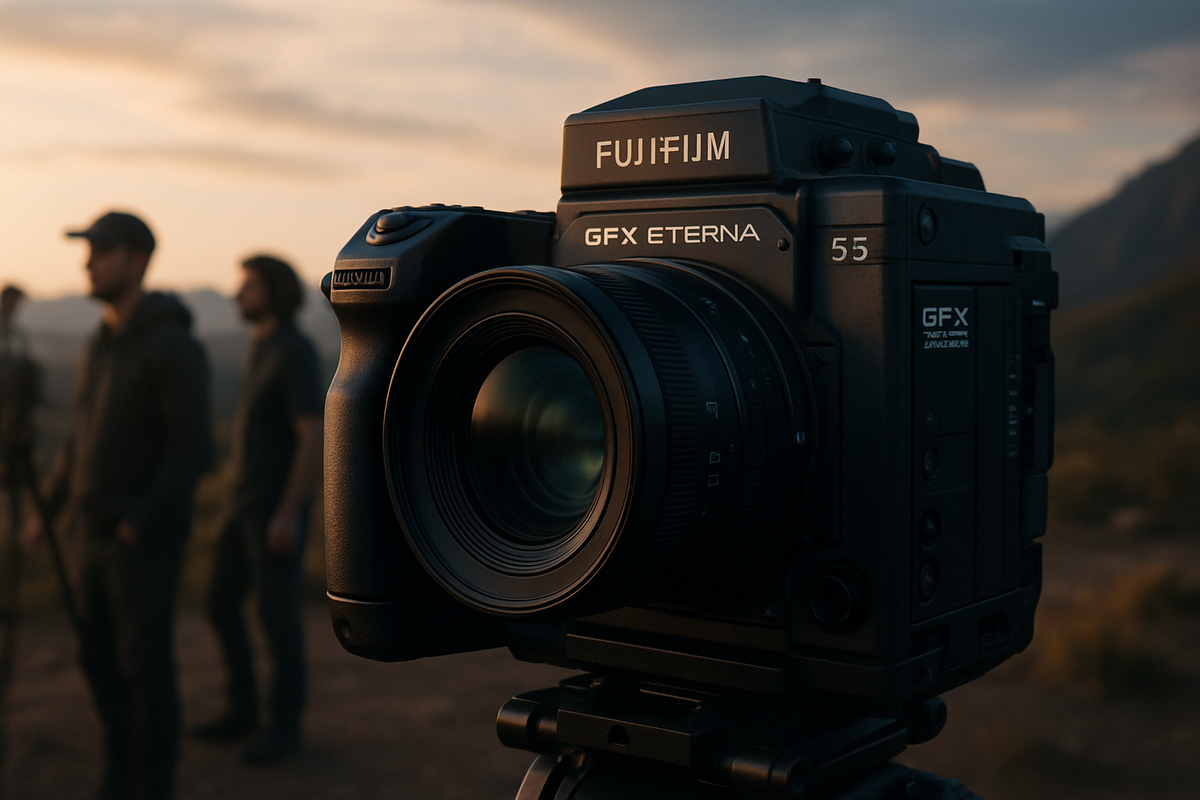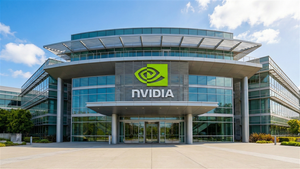
TOKYO, Japan – October 14, 2025 – Fujifilm India's recent launch of the GFX ETERNA 55 cinema camera has sent ripples through the filmmaking industry, signaling a significant advancement in cinematic technology and a bold move by Fujifilm (TYO: 4901) into the dedicated professional filmmaking market. Featuring what Fujifilm proudly touts as the world's "tallest" large-format sensor for filmmaking, this camera is poised to redefine visual aesthetics and democratize access to high-end cinematic looks.
The GFX ETERNA 55, with its groundbreaking 102-megapixel medium-format sensor, is more than just a new camera; it represents Fujifilm's strategic commitment to bringing its rich heritage in color science and film stock to the digital cinema realm. Its aggressive pricing of approximately $16,499.95 is set to disrupt the market, offering independent filmmakers and smaller production houses the opportunity to own a camera capable of producing images traditionally associated with much higher-budget productions.
A New Era of Visuals: Unpacking the ETERNA 55's Capabilities
The Fujifilm GFX ETERNA 55 is a purpose-built cinema camera, designed from the ground up to meet the rigorous demands of professional productions. At its heart lies the GFX 102MP CMOS II HS sensor, measuring a substantial 43.8mm x 32.9mm, making it approximately 1.7 times larger than a standard 35mm full-frame sensor. This expansive sensor allows for a unique cinematic aesthetic characterized by an exceptionally shallow depth of field, rich tonal expression, and superior image quality, all contributing to a more immersive visual experience.
The camera's capabilities extend to capturing stunning detail with up to 8K/30P, 4K/60fps, and HD/120fps recording options. Its native 4:3 Open Gate format, reminiscent of 4-perf Super 35mm but on a grander scale, offers immense creative flexibility for both spherical and anamorphic lens applications. Filmmakers can choose from five main formats – GF, Premista, 35mm, ANAMORPHIC (35mm), and Super35 – to tailor their visual narrative. Leveraging Fujifilm's nearly 90 years of film heritage, the ETERNA 55 incorporates 20 Film Simulations, including the popular ETERNA and ETERNA BLEACH BYPASS, alongside support for up to 16 in-camera 3D LUTs for precise color grading. The camera also boasts over 14 stops of dynamic range with F-Log2 and a Dual Base ISO system (800 and 3200), ensuring exceptional performance across diverse lighting conditions.
For streamlined post-production, the GFX ETERNA 55 supports internal recording in Apple ProRes 422 HQ, ProRes 422, ProRes 422 LT, and ProRes 422 Proxy, as well as H.265/HEVC and H.264 codecs. It can also output 8K/30P 12-bit RAW video via HDMI. A notable innovation is the world's first internal electronic variable ND filter in a large-format sensor camera, offering seamless density control from ND0.6 to ND2.1. Fujifilm has also integrated an optimized Optical Low-Pass Filter (OLPF) to combat moiré and false colors. With a native FUJIFILM G-mount and a bundled PL Mount Adapter G, the camera ensures broad compatibility with a vast array of cine-style lenses. Announced on September 10, 2025, with shipments commencing in October 2025, the ETERNA 55 is already generating buzz for its potential to redefine cinematic image capture.
Shifting Sands: Who Wins and Who Loses?
The introduction of the GFX ETERNA 55 will undoubtedly reshape the competitive landscape of the professional cinema camera market, creating both winners and those who face increased pressure.
Fujifilm (TYO: 4901) itself stands as the primary beneficiary. This launch solidifies its position as a serious contender in the professional cinema space, moving beyond its highly successful mirrorless and medium-format still cameras. The ETERNA 55 leverages Fujifilm's unique medium-format sensor technology and celebrated color science to offer a distinct alternative, potentially boosting sales of its Fujinon GF lenses and expanding its overall market footprint.
Established high-end players like ARRI may see some impact, particularly in the upper-mid-tier rental market. While ARRI's ALEXA series remains the gold standard for large-budget productions, the GFX ETERNA 55 offers a compelling large-format aesthetic at a significantly lower price point, potentially attracting projects that previously might have stretched for an ARRI rental. Similarly, RED Digital Cinema, known for its high-resolution KOMODO and V-RAPTOR series, faces direct competition in the large-sensor, high-resolution arena. While RED's proprietary REDCODE RAW and global shutter options offer differentiation, Fujifilm's larger sensor and unique color science present a formidable challenge.
Sony (TYO: 6758) and Canon (TYO: 7751), with their robust FX and Cinema EOS lines respectively, will likely feel pressure to further innovate in larger sensor formats or emphasize other differentiating features like advanced autofocus and proprietary lens ecosystems. The ETERNA 55's medium-format sensor offers a visual characteristic that goes beyond what most full-frame cameras provide. Even Blackmagic Design, known for its aggressively priced, high-quality cameras like the URSA and PYXIS series, will face a new competitor offering a unique sensor size and Fujifilm's renowned color science, potentially drawing away some filmmakers prioritizing that specific aesthetic.
Beyond camera manufacturers, the launch creates opportunities for lens manufacturers. Fujifilm's own Fujinon GF lens division stands to gain significantly, especially with the release of new cinema zoom lenses like the Fujinon GF 32-90mm T3.5 PZ OIS WR. The included PL-mount adapter also benefits existing PL-mount lens manufacturers, broadening the potential user base for their high-end cinema glass. Third-party accessory makers like Wooden Camera are already announcing dedicated rigs and power solutions, indicating a burgeoning ecosystem around the ETERNA 55. Post-production software companies, particularly Adobe (NASDAQ: ADBE) with its Frame.io Camera to Cloud integration, also stand to benefit from streamlined workflows.
A Wider Lens: Industry Trends and Historical Echoes
The Fujifilm GFX ETERNA 55's launch is not an isolated event but rather a significant marker within broader industry trends, particularly the inexorable shift towards larger sensors and higher resolutions in filmmaking. The camera's "tall" 4:3 open gate medium-format sensor pushes the boundaries of what's commercially available, offering an expansive canvas that caters to the growing demand for immersive, high-quality cinematic imagery. This aligns with the industry's desire to achieve shallower depth of field, richer bokeh, and a distinct visual signature that differentiates high-end productions.
The ripple effects of this launch will be felt across the entire filmmaking ecosystem. Competitors will be compelled to re-evaluate their product roadmaps, potentially accelerating research and development into larger sensor formats or focusing on unique selling propositions such as global shutters, advanced autofocus, or proprietary RAW codecs. For instance, Nikon (TYO: 7731), following its acquisition of Red Digital Cinema, is also signaling ambitions in the large-sensor cinema space, indicating a broader industry-wide movement. Partners, particularly lens manufacturers, will see increased demand for G-mount cinema lenses and adapters, fostering innovation and expansion in that ecosystem. The accessibility offered by the ETERNA 55's price point means that high-end cinematic aesthetics are no longer exclusively for blockbuster budgets, empowering independent filmmakers and boutique studios to elevate their visual storytelling.
Historically, this trend echoes the golden age of cinema, where larger film formats like 65mm/70mm were employed to create a spectacle that captivated audiences and distinguished film from television. In the digital age, the move to large-format sensors serves a similar purpose, offering a unique visual experience. The ETERNA 55 can also be seen as a continuation of the digital cinema revolution sparked by cameras like the Red One in 2007, which brought 4K resolution and film-like sensor sizes to a wider audience. Furthermore, Fujifilm's explicit connection of the ETERNA 55 to its 90-year legacy in motion picture film, particularly the ETERNA film stock, reinforces a powerful historical and artistic narrative, appealing to filmmakers who cherish traditional film aesthetics. There are no specific regulatory or policy implications associated with this camera launch, as it falls within standard product development and market competition.
The Road Ahead: Short-Term Gains and Long-Term Visions
In the short term, Fujifilm's GFX ETERNA 55 is poised to make significant inroads into specific segments of the professional cinema market. Its unique blend of a large-format sensor, renowned color science, and competitive price point makes it an attractive option for high-end independent features, commercials, music videos, and documentaries where a distinctive visual aesthetic is paramount. Fujifilm will focus on establishing the ETERNA 55 as a serious, dedicated filmmaking tool, leveraging its strong brand reputation and existing GFX user base. The camera's robust workflow features, including internal ProRes recording and Frame.io Camera to Cloud integration, will facilitate smooth integration into modern production pipelines.
Looking further ahead, the GFX ETERNA 55 could catalyze a more widespread adoption of medium format as a distinct and sought-after "look" in cinema, potentially sitting between Super 35mm and the very large formats like ARRI Alexa 65. This could prompt competitors to explore similar sensor dimensions or differentiate through other cutting-edge technologies like advanced global shutters or enhanced AI-driven features for cinematography and post-production. Fujifilm's long-term strategy will likely involve expanding its G-mount cinema lens ecosystem, introducing more dedicated video-centric accessories, and potentially diversifying its "ETERNA" camera line with different tiers or modular systems.
Market opportunities will emerge for filmmakers seeking a unique visual signature, for content creators demanding higher quality, and for specialized productions requiring specific aspect ratios or extreme shallow depth of field. However, challenges remain, particularly in building a comprehensive native G-mount cinema lens ecosystem and ensuring seamless integration into established rental house workflows dominated by ARRI and RED. The rolling shutter characteristics of large CMOS sensors will also be a point of scrutiny for fast-motion sequences. Ultimately, the ETERNA 55 could lead to a more specialized and diverse filmmaking toolkit, where cameras are chosen for their unique artistic capabilities rather than just technical specifications, fostering continued innovation across the industry.
Final Cut: A New Horizon for Filmmaking
The launch of the Fujifilm GFX ETERNA 55 is a landmark event, signaling Fujifilm's decisive entry into the professional digital filmmaking arena. The camera's 102-megapixel large-format sensor, capable of stunning 8K capture, coupled with Fujifilm's revered color science and a competitive price point, represents a powerful new tool for cinematographers. It's a clear statement that Fujifilm is leveraging its deep roots in photographic and cinematic history to shape the future of digital image capture.
Moving forward, the market will likely see an increased emphasis on distinct visual aesthetics and creative flexibility, driven by cameras like the ETERNA 55. While established players will continue to innovate, Fujifilm has carved out a unique niche that prioritizes the "fullest-frame" look and rich tonal expression. This democratizes access to high-end cinematic qualities, empowering a broader range of filmmakers to realize their artistic visions. The lasting impact will be a more diverse and creatively rich landscape for filmmaking, pushing the boundaries of visual storytelling.
Investors should closely monitor the adoption rate of the GFX ETERNA 55, particularly its penetration into independent film productions and commercial projects. Key indicators will include sales figures, the expansion of the G-mount cinema lens ecosystem, and positive feedback from industry professionals regarding its performance and workflow integration. Furthermore, keeping an eye on how competitors respond – whether through new product announcements, strategic partnerships, or pricing adjustments – will provide insights into the evolving dynamics of the high-end cinema camera market. Fujifilm's commitment to ongoing firmware updates and the development of future "ETERNA" line products will also be crucial signals of its long-term dedication to this exciting new venture.
This content is intended for informational purposes only and is not financial advice






